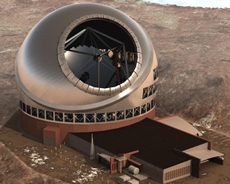Ladakh may host largest telescope TMT as Hawaii project halts
03 May 2016
India could be making a huge gain on the scientific front if the country emerges as the host for the world's largest telescope project, after protests in Hawaii in the US halted construction of the proposed Thirty Metre Telescope (TMT) project and the promoters started looking for alternative sites, which included Hanle in India's Ladakh.
 The Thirty Metre Telescope (TMT) project aimed at exploring the universe is likely to be relocated to Hanle in Ladakh, after protests by locals and indigenous population at Mauna Kea in Hawaii, where it was to come up originally, stalled the project.
The Thirty Metre Telescope (TMT) project aimed at exploring the universe is likely to be relocated to Hanle in Ladakh, after protests by locals and indigenous population at Mauna Kea in Hawaii, where it was to come up originally, stalled the project.
India is expected to invest about $212 million in the TMT project and the Indian Institute of Astrophysics (IIA) at Bengaluru and Inter-University Centre for Astronomy and Astrophysics (IUCAA) at Pune have been actively involved in the TMT project for around 3 years now.
Construction of the `Thirty Metre Telescope' (TMT), estimated cost $1.47 billion (Rs98.26 crore), was to start in Mauna Kea, Hawaii, but a verdict given by the Hawaii Supreme Court, cancelled the permit to build the TMT in 2015.
The Hawaiian Supreme Court cancelled the allocation of land for the project as the land was considered sacred for the community residing there (See: After Hawaii hurdle, Ladakh may get world's largest telescope).
While the Hawaiian government is looking for renewal of permission to build the telescope, the TMT board has started looking for alternative locations that ended on Ladakh. An international inspection team will soon be coming to visit Ladakh to finalise plans and avoid further project delays.
The Indian Astronomical Observatory is also developing the edge sensor actuators and system support assemblies apart from the software support to TMT.
Along with Ladakh in India, the board had decided on another prospective site in Chile but the large amount of investment and challenges involved in it has stalled its prospects.
Department of Science and Technology (DST) and Department of Atomic Energy are the government agencies helping in the project.
The project is looking for the favorable and prospective site both in northern and southern hemispheres.
India is a 10 per cent partner in the TMT project, which includes China, Japan, Canada and the US. On the Indian side, the project is being handled by the ministry of science and technology and the Department of Atomic Energy.
If the project comes to India, it will open several doors. "The project is expected to improve employment opportunities for the local people besides development of the region. TMT being the largest optical and infrared telescope in the northern hemisphere will strengthen the domestic programme of the country in this field and lead to several discoveries, which will inspire future generations.
"The project will also help develop state-of-the-art high end technologies and expertise in the country," an official of ministry of science and technology said.






























